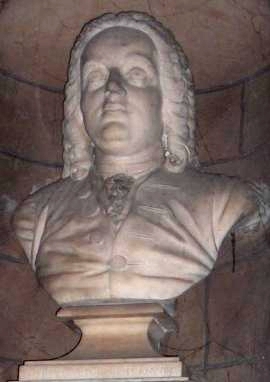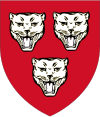
Earl Ferrers is a title in the Peerage of Great Britain. It was created in 1711 for Robert Shirley, 14th Baron Ferrers of Chartley. The Shirley family descends from George Shirley of Astwell Castle, Northamptonshire. In 1611 he was created a Baronet, of Staunton Harold in the County of Leicester, in the Baronetage of England. He was succeeded by his son Henry, the second Baronet, who married Lady Dorothy Devereux, daughter of Robert Devereux, 2nd Earl of Essex. On the death of her brother Robert Devereux, 3rd Earl of Essex, she became the youngest co-heir to the baronies of Ferrers of Chartley and the barony of Bourchier, which had fallen into abeyance on the death of the third Earl. Shirley was succeeded by his eldest son, the third Baronet. He died unmarried and was succeeded by his younger brother, the fourth Baronet. He was imprisoned in the Tower of London by Oliver Cromwell and died there in 1656. On his death the title passed to his eldest son, the fifth Baronet. He died at an early age and was succeeded at birth by his posthumous son, the sixth Baronet.

Earl Peel is a title in the Peerage of the United Kingdom. The Peel family descends from Robert Peel, eldest son of a wealthy cotton merchant. The family lands, known as Drayton Manor, in the County of Stafford would become more commonly known in modern-day as an amusement park. The family seat is Elmire House, near Ripon, North Yorkshire.

Earl of Gosford is a title in the Peerage of Ireland. It was created in 1806 for Arthur Acheson, 2nd Viscount Gosford.

Earl of Kingston is a title in the Peerage of Ireland. It was created in 1768 for Edward King, 1st Viscount Kingston. The Earl holds the subsidiary titles Baron Kingston, of Rockingham in the County of Roscommon, Viscount Kingston, of Kingsborough in the County of Sligo, Baron Erris, of Boyle in the County of Roscommon, and Viscount Lorton, of Boyle in the County of Roscommon, also in the Peerage of Ireland. He is also a baronet in the Baronetage of Ireland. Between 1821 and 1869 the earls also held the title Baron Kingston, of Mitchelstown in the County of Cork, in the Peerage of the United Kingdom.

Earl of Limerick is a title that has been created twice in the Peerage of Ireland, associated first with the Dongan family, then with the Pery family. It should not be confused with the title Viscount of the City of Limerick held by the Hamilton family also Earls of Clanbrassil.

Earl of Roden is a title in the Peerage of Ireland. It was created in 1771 for Robert Jocelyn, 2nd Viscount Jocelyn. This branch of the Jocelyn family descends from the 1st Viscount, prominent Irish lawyer and politician Robert Jocelyn, the son of Thomas Jocelyn, third son of Sir Robert Jocelyn, 1st Baronet, of Hyde Hall. He notably served as the Lord Chancellor of Ireland from 1739 to 1756. In 1743, he was raised to the Peerage of Ireland as Baron Newport, of Newport, and in 1755 he was further honoured, when he was made Viscount Jocelyn, also in the Peerage of Ireland. He was succeeded by his son, the second Viscount. He represented Old Leighlin in the Irish House of Commons and served as Auditor-General of Ireland. In 1770 he also succeeded his first cousin once removed as fifth Baronet of Hyde Hall. In 1771 he was created Earl of Roden, of High Roding in the County of Tipperary, in the Peerage of Ireland. Lord Roden married Lady Anne Hamilton, daughter of James Hamilton, 1st Earl of Clanbrassil and sister of James Hamilton, 2nd Earl of Clanbrassil, a title which became extinct in 1798.

Earl of Lonsdale is a title that has been created twice in British history, firstly in the Peerage of Great Britain in 1784, and then in the Peerage of the United Kingdom in 1807, both times for members of the Lowther family.

William Parsons, 3rd Earl of Rosse, was an Irish astronomer, naturalist, and engineer. He was president of the Royal Society (UK), the most important association of naturalists in the world in the nineteenth century. He built several giant telescopes. His 72-inch telescope, built in 1845 and colloquially known as the "Leviathan of Parsonstown", was the world's largest telescope, in terms of aperture size, until the early 20th century. From April 1807 until February 1841, he was styled as Baron Oxmantown.
William Parsons may refer to:

Baron Dufferin and Claneboye, of Ballyleidy and Killyleagh in County Down, Northern Ireland, is a title in the Peerage of Ireland. It was created on 30 July 1800 for Dame Dorcas Blackwood, widow of Sir John Blackwood, 2nd Baronet, Member of the Irish Parliament for Killyleagh and Bangor, in return for support for the Union of Ireland and the United Kingdom.

Earl of Bellomont, in the Kingdom of Ireland, was a title that was created three times in the Peerage of Ireland. The first creation came on 9 December 1680 when Charles Kirkhoven, 1st Baron Wotton, was made Earl of Bellomont. He had already been created Baron Wotton, of Wotton in the County of Kent, in the Peerage of England on 31 August 1650. He was childless and both titles became extinct on his death in 1683.
William Clere Leonard Brendan Parsons, 7th Earl of Rosse, is an Anglo-Irish peer. He is also 10th Baronet Parsons, of Birr Castle.

William Edward Parsons, 5th Earl of Rosse was an Irish peer and British Army officer. He was known as Lord Oxmantown until 1908.

Lawrence Parsons, 2nd Earl of Rosse, known as Sir Lawrence Parsons, Bt, from 1791 to 1807, was an Irish peer.

Richard Parsons, 1st Earl of Rosse, Freemason and a founder-member of the Hell-Fire Club, 2nd Viscount Rosse of Bellamont co. Dublin, Baron Oxmantown, 3rd baronet.
There have been four baronetcies created for people with the surname Parsons, two in the Baronetage of Ireland, one in the Baronetage of England and one in the Baronetage of the United Kingdom. One creation is still extant as of 2008.
Lawrence Harman Parsons, 1st Earl of Rosse, known as The Lord Oxmantown between 1792 and 1795 and as The Viscount Oxmantown between 1795 and 1806, was an Anglo-Irish peer and politician.
Sir William Parsons, 1st Baronet of Bellamont, PC (Ire), was known as a "land-hunter" expropriating land from owners whose titles were deemed defective. He also served as Surveyor General of Ireland and was an undertaker in several plantations. He governed Ireland as joint Lord Justice of Ireland from February 1640 to April 1643 during the Irish rebellion of 1641 and the beginning of the Irish Confederate War.
Events from the year 1677 in Ireland.
Sir Lawrence Parsons was an English-born barrister, judge and politician in seventeenth-century Ireland, who enjoyed a highly successful career, despite frequent accusations of corruption and neglect of official duty. His success owed much to the patronage of his uncle Sir Geoffrey Fenton, of his cousin by marriage Richard Boyle, 1st Earl of Cork, and of the prime Royal favourite, the Duke of Buckingham. He was the ancestor of the Earl of Rosse of the second creation. He rebuilt Birr Castle, which is still the Parsons family home.














